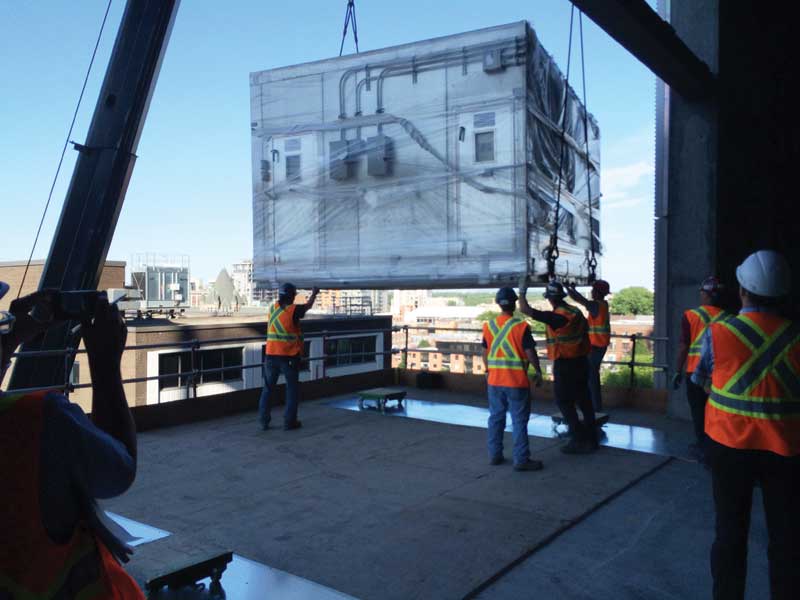Introducing energy recovery ventilation

Image courtesy Sheridan College
Sustainable equipment visibility does not stop there. The building will also host the campus’ new two-storey central plant mechanical room or ‘energy centre.’ Chillers, boilers, combined heat-power engines (CHP), and other essential central plant equipment supplies much of the campus, which is located in the Energy Centre’s glass enclosure, visible from the exterior and interior first- and second-floor corridors.
“The strategy at Sheridan College is to get people interested in sustainability and technology by showing it to them, rather than concealing it out of sight,” said Sinnock, who pointed out the centre is strategically located
between the engineering technology and skilled trades departments to draw potential synergy between the two academic programs.
Furthermore, putting the mechanical equipment in eyesight with potential accessible learning by students is an incentive to add HVAC/R and stationary engineering to a list of trade curriculums, already including electrical, plumbing, and welding.
“This building provides a platform for the college to roll into those programs where technologies such as ERVs can be studied,” said Sinnock.
In addition, Sheridan used the ERV technology to supplement six new rooftop direct-expansion (DX) HVAC systems in 2009. Two years later, the college constructed a building with a DOAS ERV and zone-based air tempering with heat pumps. In 2015, it replaced aged air-handling units (AHU) in one of its legacy buildings with a new system incorporating ERVs. In each case, the energy consumption was reduced because the ERVs were reclaiming the building’s heating and cooling.
Hospital designs
While Sheridan is a prime example of a university using ERVs, the technology is seen as nearly irreplaceable in new hospital HVAC designs to help comply with ASHRAE 170, Ventilation in Healthcare Facilities, as well as to reduce excessive humidity that nourish airborne biological contaminants.

Image courtesy SEMCO LLC
Statistics surrounding hospital-acquired infections show a sense of emergency. One in every nine patients acquires HAI once entering a Canadian hospital, notes the Canadian Union of Public Employees (CUPE) on its website.
To offset the trend, many hospitals are looking to reduce 100 per cent outdoor air HVAC systems in an air replacement strategy. The entire air volume in a hospital can be replaced quickly by introducing 100 per cent outdoor air, and exhausting interior air along with any of its potential airborne contaminates.
Air replacement is a viable strategy, but it is cost-prohibitive to dehumidify heat or cool a huge volume of air surpassing 1 million cfms in larger facilities. Thus, facility engineers walk a tightrope when it comes to reducing operational HVAC energy costs while complying with ASHRAE 170.
Further, the challenge for hospital management is to maintain code-compliance, even though relative humidity (RH) levels can vary between spaces, such as a corridor, patient room, and surgery suite. Regardless of safe design precautions, such as controlling air changes and a room’s negative or positive pressurization, moisture will migrate from room to room, because of its affinity for drier spaces. Thus, controlling the RH in each space makes it easier to control the various vapour pressures and moisture migration into other spaces.







